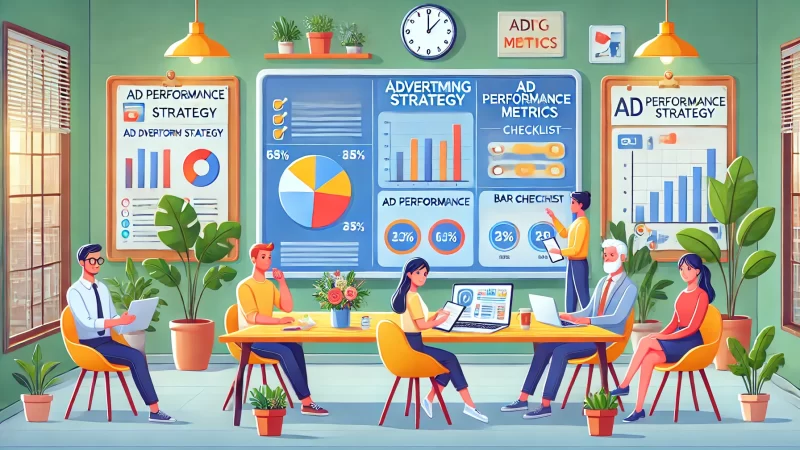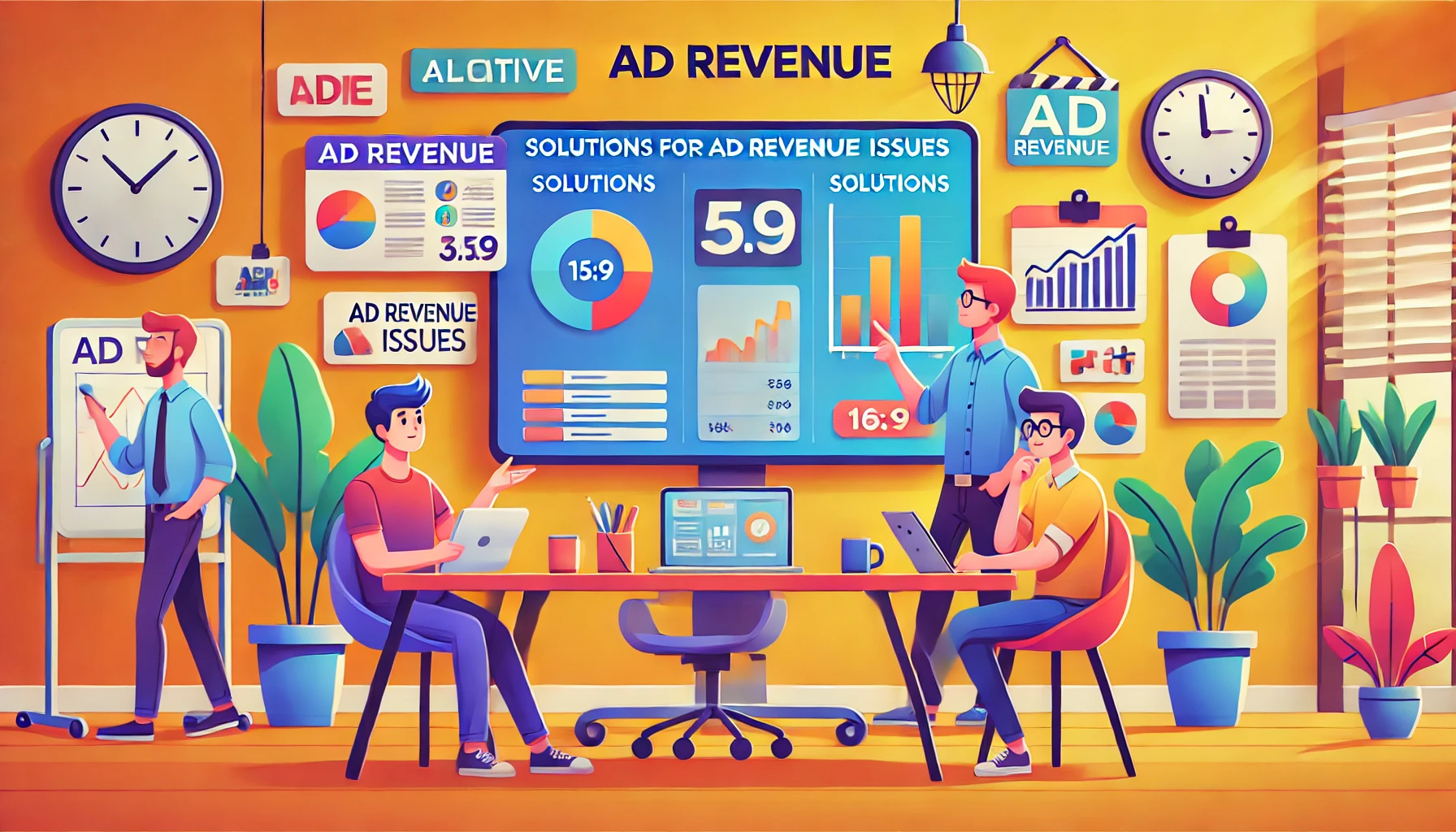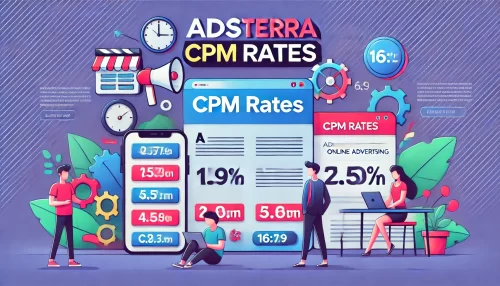Table of Contents
Is your ad revenue plummeting despite efforts to stabilize it? Wondering what might be causing the dip and how to recover quickly? In this guide, we’ll explore actionable strategies to fix declining ad revenue, address potential pitfalls, and maximize your earnings.
Understanding The Causes Of Dropping Ad Revenue
Ad revenue declines often result from a mix of external and internal factors. Understanding these causes helps you take corrective actions to recover lost earnings and strengthen your revenue streams in an increasingly competitive digital landscape.
Common Market Trends Impacting Ad Revenue
Market trends significantly influence ad revenue. Economic downturns, industry shifts, and evolving consumer preferences can reduce ad budgets, affecting publishers’ earnings. Being aware of these trends allows you to anticipate and adapt effectively.
Economic changes impact advertising budgets directly. During recessions, advertisers prioritize essential campaigns, leaving other channels underfunded. I recommend staying proactive by diversifying ad placements and focusing on formats in demand to remain competitive.
New technologies like AI and virtual reality can disrupt traditional ad models. Publishers who stay updated on innovations can pivot early, gaining an edge. Keeping tabs on these developments will help you align your strategies with industry demands.
Consumer priorities, such as privacy and transparency, are reshaping the advertising space. Addressing these concerns builds trust, making your audience more receptive to ads. Trust leads to higher engagement and ultimately better ad revenue.
Competitor analysis offers insights into tactics that are working in your niche. I suggest exploring how your competitors are leveraging trends to maintain or increase ad revenue and identifying gaps to fill in your strategy.
How User Behavior Changes Affect Earnings
User behavior drives ad engagement. When audience habits shift, it directly impacts revenue. To counteract this, publishers must align their strategies with audience preferences, enhancing user experience to sustain ad impressions and clicks.
If users spend less time engaging with content, ad impressions drop. Creating high-value, tailored content ensures you hold their attention. I advise closely analyzing your audience’s browsing patterns to identify their interests and build accordingly.
A shift toward video content has reduced engagement with static ads. Adapting to this trend by incorporating video ad formats can help you attract a broader audience and improve overall performance metrics like CTR (click-through rate).
Users increasingly value their privacy. Websites that ensure transparency and build trust through clear data policies experience better ad engagement. Consider displaying opt-in options for data sharing to make users feel more comfortable.
Monitoring bounce rates and session duration provides insights into how well ads perform. Adjust placements based on this data to boost engagement. This continual optimization process can make a significant difference in ad revenue over time.
Role Of Ad Blockers In Lower Revenue
Ad blockers hinder revenue by preventing ads from being displayed. Publishers who take a user-first approach to address this challenge can regain some of these lost earnings without sacrificing trust or user satisfaction.
Intrusive ads often lead to increased adoption of ad blockers. Switching to user-friendly formats like native ads minimizes frustration and improves user experience, making it less likely for audiences to use blocking software.
Offering value-packed content can encourage users to disable ad blockers for your site. When readers find meaningful, engaging material, they are more inclined to whitelist your domain to support the platform.
Subscription-based models or premium content offerings reduce reliance on ads. I suggest exploring these monetization options as sustainable alternatives to traditional ad revenue streams, especially for ad-block-heavy audiences.
Ad-block detection tools help identify users who block ads, allowing publishers to display personalized messages encouraging support. Testing such tools can be beneficial for recovering a portion of lost earnings while maintaining goodwill.
Identifying Seasonal Patterns In Revenue Decline
Seasonal revenue drops can often be predicted. By analyzing these patterns, publishers can implement strategies to offset fluctuations and capitalize on high-earning periods more effectively.
Advertisers frequently reallocate budgets during holidays or fiscal year-end periods, causing spikes or dips in revenue. Identifying these trends allows you to adjust your ad placements and content themes to align with advertiser priorities.
User engagement often drops during off-peak seasons. For example, educational sites may see a decline in summer. Offering season-specific content ensures steady audience interaction, even during quieter times.
Seasonal promotions or events drive specific ad trends. Creating content tailored to these campaigns, such as holiday guides or trend-based articles, can increase clicks and improve earnings. Anticipating these shifts is key.
Analyzing historical data provides clarity on how revenue cycles behave year-to-year. Use this data to strategize ad placements, prepare for downturns, and enhance performance during peak periods for sustained growth.
Evaluating Your Current Ad Strategy Effectiveness

Improving your ad strategy starts with evaluating its current effectiveness. I suggest analyzing key areas such as placements, formats, and audience targeting to identify weak points that might be limiting your potential ad revenue.
How Ad Placement Can Make Or Break Revenue
Ad placement is a crucial factor in determining revenue success. Poorly positioned ads may fail to capture user attention, while strategic placements significantly enhance visibility and engagement, translating into higher ad revenue and a better return on investment.
Ads perform better when placed in high-visibility areas, such as above the fold or embedded within engaging content. I advise conducting tests to determine which placements capture the most attention without disrupting the user experience.
Poor placement can lead to ad fatigue or frustration, especially with intrusive formats like pop-ups. Opting for placements that flow naturally with your content ensures users remain engaged and more likely to interact with your ads.
Monitoring heatmaps provides valuable insights into how users navigate your site and interact with ads. This data helps refine placements to focus on high-traffic areas, increasing click-through rates and overall ad revenue.
Testing different placements regularly is essential for long-term success. What works today may not work tomorrow, so I recommend a dynamic approach that adjusts to changing user behavior and preferences.
The Impact Of Ad Format Selection On Earnings
Choosing the right ad formats plays a huge role in maximizing revenue. Some formats drive better engagement and conversion rates, while others may hinder user experience and result in lower ad performance over time.
Video ads, for example, often achieve higher engagement rates than static banners. They catch users’ attention quickly and can deliver detailed messages effectively. I believe adding video options to your inventory can boost revenue significantly.
Native ads blend seamlessly with your content, reducing disruption and increasing click-through rates. This format builds trust while maintaining user interest, making it a win-win for both publishers and advertisers.
Interstitial and pop-up ads can backfire if overused. While they might provide a short-term boost, excessive reliance on these formats risks alienating users and increasing bounce rates, ultimately harming revenue.
Experimenting with emerging ad formats like interactive or augmented reality ads is worth considering. These engaging options provide new ways to captivate audiences, especially for brands targeting tech-savvy or younger demographics.
Analyzing Audience Targeting For Optimal Performance
Audience targeting ensures your ads reach the right people at the right time. Understanding your audience deeply is vital for crafting campaigns that resonate and generate maximum ad revenue effectively.
I suggest using analytics tools to segment your audience based on demographics, location, and preferences. This data helps tailor your ads to match user expectations, driving higher engagement and clicks.
Behavioral targeting improves ad performance by delivering content based on users’ past actions. For instance, retargeting visitors who didn’t convert can bring them back, improving ROI on your campaigns.
Lookalike audiences are a great way to scale targeting efforts. These users share similar traits with your best-performing segments, enabling you to expand reach without sacrificing engagement or relevance.
Regularly reviewing targeting metrics ensures your efforts stay aligned with user needs. Adapting to trends or shifts in audience behavior keeps your strategies effective and your ad revenue growing.
Identifying High-Performing Vs. Low-Performing Ads
Knowing which ads work and which don’t is the key to optimizing revenue. Focus your efforts on high-performing ads while tweaking or removing low-performing ones to improve overall campaign efficiency.
I recommend setting KPIs like CTR, CPM, or conversion rates to assess ad performance. These metrics provide a clear picture of which ads deliver value and which need reworking.
A/B testing is an invaluable tool for identifying high-performing ads. By comparing variations, you can pinpoint what resonates most with your audience and apply those insights across campaigns.
Analyzing creative elements—like headlines, visuals, or CTAs—reveals which aspects drive user action. I suggest updating underperforming ads with proven elements to see if performance improves.
Automation tools can streamline the process of evaluating ad performance. These solutions help you track trends, identify weak points, and make data-driven decisions faster, saving time while improving revenue outcomes.
Improving Website Performance To Boost Ad Revenue
Website performance plays a pivotal role in determining ad revenue. Faster, user-friendly websites attract and retain visitors, increasing engagement and ad interactions. I suggest prioritizing performance optimizations to create a seamless experience that supports revenue growth.
Importance Of Website Speed For Ad Engagement
A slow website discourages user interaction, directly affecting ad engagement. Users expect fast-loading pages, and delays can cause them to abandon your site before even seeing the ads. Speed optimization is essential to maximize ad revenue opportunities.
Website speed impacts first impressions significantly. I recommend using tools like Google PageSpeed Insights to identify slow-loading elements and optimizing them. Faster-loading websites keep users engaged longer, increasing the likelihood of ad impressions and clicks.
Caching and compression tools can drastically improve loading times. Compressing images and enabling browser caching ensure smoother performance, which creates a better user experience and encourages higher ad engagement rates.
Content delivery networks (CDNs) distribute your site’s content across servers globally, reducing latency. This ensures visitors experience consistently fast loading times, which positively impacts both user satisfaction and ad revenue.
Regular speed audits help maintain optimal performance. Issues like bloated code or unoptimized scripts can arise over time, so ongoing monitoring is crucial to ensure your site continues to perform efficiently.
How Mobile Responsiveness Enhances Revenue
With mobile traffic dominating the web, a responsive design is essential for boosting ad revenue. Sites that adapt seamlessly to various screen sizes ensure users have an enjoyable experience, leading to better engagement and higher earnings.
Mobile users have little patience for poorly optimized websites. I suggest adopting a mobile-first design approach, ensuring all elements, including ads, are easily viewable and functional on smaller screens.
Responsive ad formats improve mobile engagement. Formats like sticky ads or native ads blend well with mobile interfaces, making them less intrusive and more likely to generate clicks and revenue.
Testing across devices reveals gaps in your site’s responsiveness. I recommend regularly testing your design and functionality on various devices to ensure ads display correctly and attract user interaction.
Investing in mobile-friendly navigation enhances the user experience. Intuitive menus and layouts make it easier for users to engage with content and ads, improving click-through rates and overall revenue.
Reducing Bounce Rates To Improve Ad Earnings
Bounce rates reflect the percentage of visitors who leave your site without interacting. High bounce rates signal issues that can hurt ad revenue. Fixing these problems keeps users engaged longer, increasing ad views and clicks.
Slow loading times are a major contributor to bounce rates. I advise optimizing your site’s speed to ensure users stay on the page long enough to interact with ads and explore your content.
Poor navigation frustrates users and drives them away. Simplifying site structure and improving internal linking keeps visitors engaged and encourages them to explore more, increasing the number of ad impressions.
Engaging visuals and interactive elements help retain visitors. I suggest adding attention-grabbing features like videos or infographics to make your site more appealing, reducing the likelihood of users bouncing.
Addressing irrelevant or low-quality content is critical. High-quality, audience-targeted material keeps users on your site longer, creating more opportunities for them to engage with ads and boosting revenue.
The Role Of Content Quality In Maximizing Revenue
Content quality directly influences user engagement and ad revenue. Well-crafted, valuable content keeps users coming back, increasing the chances of ad clicks and boosting your earnings over time.
Creating content tailored to your audience’s needs is essential. I believe understanding what your audience values and addressing their pain points ensures better engagement with your site and its ads.
Content must be optimized for readability. Short paragraphs, bullet points, and subheadings make information easy to digest, encouraging visitors to stay on your page and interact with your ads.
Consistent content updates maintain relevance and attract repeat visitors. Regularly posting fresh, engaging material shows users your site is active and worth revisiting, boosting overall traffic and ad revenue.
Using visuals strategically enhances content appeal. High-quality images, videos, and graphics not only engage users but also complement ads, encouraging more interactions and improving overall revenue potential.
Optimizing Ad Inventory For Maximum Profit

Effective ad inventory management ensures you maximize revenue potential without compromising user experience. Balancing ad volume, pricing strategies, and analytics-based insights will help you achieve sustainable growth and profitability.
Balancing Ad Quantity And User Experience
Too many ads can overwhelm users, while too few limit revenue potential. Striking the right balance is critical for maintaining a positive user experience while maximizing earnings from ad inventory.
Excessive ads can frustrate visitors and increase bounce rates. I recommend prioritizing quality over quantity, focusing on impactful placements that enhance engagement without disrupting the browsing experience.
Experiment with different ad densities to find the sweet spot for your audience. Testing fewer ads on high-traffic pages often reveals optimal layouts that boost engagement and revenue.
Integrating ads naturally into content ensures they’re less intrusive. Native ads that align with the tone and theme of your site create a seamless experience, increasing user trust and click-through rates.
Monitoring user feedback provides valuable insights into ad impact. Negative responses to ad volume or placement can signal the need for adjustments to improve both user satisfaction and revenue.
Leveraging Dynamic Pricing Models For Ads
Dynamic pricing models help maximize revenue by adjusting ad costs based on demand. Using these models ensures advertisers pay a fair price while publishers optimize earnings.
Programmatic platforms automatically adjust prices for premium placements. I suggest integrating these tools to ensure your inventory is priced competitively, capturing the highest possible value from advertisers.
Real-time bidding (RTB) creates opportunities for high-value placements. RTB allows advertisers to compete for premium spots, driving up prices and boosting revenue without additional effort from publishers.
Segmenting inventory based on demand helps maintain value. High-demand spots can command premium prices, while less competitive spaces can be used for experimentation with ad formats or content.
Tracking performance metrics ensures pricing remains competitive. Regularly analyzing CPM, CTR, and ROI provides a clearer picture of which ads justify higher prices and which need recalibration.
Using Analytics To Improve Ad Revenue Allocation
Analytics tools are invaluable for managing and optimizing ad revenue. These tools provide actionable insights into performance, enabling you to allocate inventory strategically for maximum profit.
Heatmaps show where users engage most, helping identify high-performing sections. I suggest using this data to place premium ads in the most engaging areas, ensuring better results and higher revenue.
Ad performance metrics reveal opportunities for improvement. Tracking impressions, clicks, and conversions helps identify underperforming placements that can be optimized for better results.
Segmentation enables targeted optimization. Grouping inventory by device, location, or audience segment allows you to deliver more personalized ads, increasing engagement and earnings.
Experimentation with A/B testing provides clear comparisons. Testing different layouts or formats ensures you continually improve ad placements, optimizing revenue across your inventory.
Tools For Managing And Optimizing Ad Inventory
Ad management tools simplify inventory oversight, ensuring you make data-driven decisions. These platforms help track performance, automate pricing, and improve revenue outcomes efficiently.
Google Ad Manager offers robust inventory management features. I recommend using it to streamline operations, from placement tracking to pricing adjustments, all in one platform.
Header bidding solutions maximize revenue potential by allowing multiple advertisers to bid for inventory simultaneously. This approach increases competition and drives up ad prices for premium spots.
Analytics tools like Google Analytics provide deep insights into ad performance. Regularly reviewing these metrics ensures you’re optimizing placements and formats to achieve the best results.
Programmatic platforms simplify inventory allocation. Automating ad placements and pricing helps maintain efficiency, freeing up time for other strategic tasks while maximizing revenue.
Exploring Programmatic Advertising Benefits
Programmatic advertising revolutionizes ad placements by using automation to streamline processes. I believe embracing programmatic tools allows publishers to achieve better efficiency, reach the right audience, and maximize ad revenue with minimal manual intervention.
What Is Programmatic Advertising And How It Helps
Programmatic advertising uses software to buy and sell ad inventory automatically. This approach eliminates manual negotiations and optimizes placements, ensuring ads reach the right audience at the right time, increasing engagement and improving revenue potential.
Programmatic platforms use data and algorithms to deliver highly targeted ads. I suggest adopting these systems to reach users more effectively, as they consider demographics, browsing habits, and interests to match ads with the ideal audience.
Traditional ad buying often involves lengthy negotiations and guesswork. Programmatic solutions speed up the process, allowing publishers to allocate their inventory quickly and focus on delivering high-quality content to their audience.
Transparency is another benefit of programmatic advertising. Publishers can access detailed insights into how their inventory is performing, enabling them to fine-tune strategies and identify new opportunities to increase revenue.
Cost efficiency is a key advantage. Programmatic platforms often reduce overhead costs associated with ad buying, freeing up resources to invest in content creation or other monetization efforts that support sustainable revenue growth.
Tools To Automate And Optimize Ad Placements
Programmatic tools are essential for publishers looking to simplify ad placement and maximize revenue. These platforms streamline processes, provide actionable insights, and ensure optimal performance with minimal manual input, making them a smart investment.
Google Ad Manager is a popular tool for automating ad inventory. It simplifies placement, pricing, and reporting, ensuring publishers can focus on strategy without getting bogged down by technical tasks. I recommend exploring this platform for seamless management.
Header bidding solutions like Snigel are another effective option. These tools allow multiple advertisers to compete for ad placements in real time, driving up prices and ensuring publishers secure the best possible value for their inventory.
Programmatic platforms often integrate with analytics tools, providing comprehensive insights into ad performance. This data is invaluable for identifying top-performing placements and optimizing underperforming areas to improve overall revenue.
AI-driven platforms enhance targeting and ad customization. I believe leveraging these advanced tools ensures ads resonate better with audiences, driving higher engagement and increasing the likelihood of conversions.
Understanding Real-Time Bidding For Better Revenue
Real-time bidding (RTB) allows advertisers to bid for ad space as users load pages. This competitive, auction-based process ensures publishers achieve the highest price for their inventory, maximizing ad revenue while maintaining user experience.
RTB optimizes inventory value by ensuring only the highest-paying advertisers win placements. This automated process removes the need for manual negotiations, saving time and delivering better financial outcomes for publishers.
Advertisers love RTB because it ensures precise targeting. Ads are shown only to users who match specific criteria, improving engagement rates. I suggest exploring RTB solutions to align your ad strategy with advertiser expectations.
RTB platforms also provide data-driven insights. Publishers can monitor which ads perform best and adjust their strategies accordingly, continually improving results and maintaining a competitive edge in the market.
Implementing RTB is straightforward with programmatic tools. I recommend experimenting with these platforms to see how real-time competition can elevate your revenue and improve overall ad performance.
Monitoring And Adjusting Programmatic Campaigns
Programmatic campaigns require ongoing monitoring to achieve the best results. I advise treating them as dynamic entities, regularly reviewing performance and making data-driven adjustments to optimize outcomes and maintain steady revenue growth.
Tracking metrics like CPM (cost per mille) and CTR (click-through rate) helps identify strong-performing ads and highlight areas for improvement. These insights ensure your campaigns remain effective and profitable over time.
Ad fatigue is a common issue in programmatic campaigns. Rotating creatives and refreshing ad content regularly prevents user disengagement, maintaining consistent revenue while ensuring your inventory stays appealing to advertisers.
Seasonal trends impact campaign performance significantly. I recommend aligning programmatic strategies with current market conditions and audience behavior to maximize engagement and revenue during peak periods.
Leveraging predictive analytics can enhance campaign performance. These tools anticipate user behavior, helping publishers refine targeting and optimize placements for improved results without increasing effort.
Addressing Audience Monetization Challenges

Monetizing your audience effectively requires diversifying revenue streams and understanding their needs. I believe exploring alternatives to traditional ads, such as subscriptions or premium content, ensures a steady income while enhancing user satisfaction.
How To Diversify Revenue Streams Beyond Ads
Relying solely on ad revenue can be risky. Diversifying your income streams reduces dependence on a single source and creates a more stable financial foundation, ensuring consistent growth even during market fluctuations.
Affiliate marketing offers an alternative income source. Promoting products or services relevant to your audience can create new revenue streams while maintaining a user-friendly experience that aligns with your brand.
Merchandising is another option. Selling branded products or exclusive content creates value for loyal users and provides a consistent revenue source. I suggest exploring these opportunities based on your audience’s interests.
Crowdfunding platforms like Patreon or Buy Me a Coffee allow fans to support creators directly. This model fosters a strong sense of community while providing a steady income that doesn’t rely on ad impressions or clicks.
Offering educational resources, such as online courses or webinars, monetizes your expertise. These resources cater to users seeking value beyond free content, creating a win-win for both publishers and their audiences.
Leveraging Subscriptions And Premium Content
Subscription models create recurring revenue streams while rewarding loyal users. Introducing premium content encourages your audience to invest in your platform and reduces reliance on fluctuating ad revenue.
Creating value-packed membership tiers ensures every user finds something worth subscribing to. I suggest offering exclusive content, ad-free experiences, or early access perks to entice subscribers and maintain their loyalty.
A well-priced subscription model balances affordability with revenue goals. Testing pricing strategies can help you identify the sweet spot that appeals to users while generating steady income.
Engaging subscribers with regular updates keeps them invested in your platform. Sharing sneak peeks of upcoming features or personalized messages fosters a sense of community and boosts retention rates.
Promoting premium content strategically ensures visibility. Highlighting benefits through newsletters or social media campaigns helps users understand why your subscription offers value worth paying for.
Understanding Audience Demographics For Better Ads
Knowing your audience demographics ensures your ads resonate. Tailoring ads to user preferences improves engagement, enhances the user experience, and increases revenue through higher click-through rates and conversions.
Demographic data provides insights into who your audience is. Understanding their age, location, and interests allows you to craft ads that align with their preferences, creating a more impactful experience.
Behavioral data reveals patterns in how users interact with your content. I suggest leveraging these insights to deliver ads that align with user actions, increasing the likelihood of engagement and conversions.
Cultural considerations are important in global markets. Ads that reflect cultural norms and values resonate better with international audiences, improving both engagement rates and revenue outcomes.
Testing ad campaigns based on demographic segments refines your strategy. Identifying what works best for specific groups ensures your efforts are targeted and effective, maximizing overall revenue potential.
Monetizing Smaller Or Niche Audiences Effectively
Smaller or niche audiences often have unique interests that can be monetized effectively. I believe focusing on quality over quantity ensures you create meaningful connections that translate into revenue.
Premium niche content attracts loyal users. Offering specialized articles, reports, or guides that cater to niche interests ensures your audience feels valued, leading to increased engagement and repeat visits.
Sponsorships from niche-relevant brands provide targeted revenue opportunities. Partnering with companies that align with your audience’s interests creates win-win scenarios that enhance trust and generate income.
Creating community-driven initiatives fosters deeper connections. Exclusive forums or events create a sense of belonging for niche audiences, encouraging long-term loyalty and opening doors to additional monetization.
Leveraging email marketing can boost niche audience engagement. Personalized newsletters with targeted content and ads ensure your communication feels relevant, increasing click-through rates and revenue.
Leveraging SEO To Enhance Ad Revenue Potential
SEO plays a pivotal role in boosting ad revenue by increasing visibility and driving organic traffic. I recommend optimizing your content for search engines to attract the right audience, improve engagement, and maximize revenue potential effectively.
How Search Rankings Influence Ad Revenue
Higher search rankings translate to greater visibility and increased traffic, which boosts ad impressions and clicks. I suggest focusing on SEO strategies that help your site rank well on relevant keywords to enhance overall ad revenue.
Search engines favor well-structured and informative content. By delivering value to your audience, you not only improve rankings but also build trust, which encourages users to interact with your ads more consistently.
Traffic from high search rankings often includes users with strong intent. These visitors are more likely to click on ads or engage with content, making SEO a crucial factor for monetizing effectively.
Strong rankings also increase your site’s authority, attracting premium advertisers. I advise maintaining quality content and ensuring your SEO practices align with search engine guidelines to maintain competitive placements.
Analyzing search ranking performance helps you identify opportunities to improve. Use tools like Serpstat to pinpoint high-performing pages and optimize underperforming ones to drive more traffic and revenue.
Importance Of Keyword Optimization For Monetization
Keywords connect your content to user searches, making optimization a cornerstone of effective monetization. I believe using relevant and high-traffic keywords strategically can significantly enhance ad revenue potential by drawing in more targeted visitors.
Long-tail keywords often capture niche audiences with specific interests. These users are more engaged and likely to click on ads. Incorporating these phrases ensures better traffic quality and increased revenue.
Keyword placement matters. I suggest using primary keywords in titles, headings, and the first 100 words to boost visibility while maintaining natural flow, ensuring SEO effectiveness without overloading the content.
Regular keyword research keeps your strategy updated. Trends shift frequently, and staying informed allows you to adapt your content to meet changing audience needs, maintaining steady traffic and ad performance.
Avoid keyword stuffing, as it can harm user experience and search rankings. Focus on meaningful integration that enhances content value while supporting ad revenue goals organically.
How To Use Organic Traffic For Better Ad Performance
Organic traffic delivers users actively seeking your content, making it a goldmine for ad revenue. I advise creating content tailored to search intent to attract engaged visitors who are more likely to interact with ads.
High-quality organic traffic stems from well-optimized content. Users who find your site helpful stay longer, explore more, and interact with ads, boosting impressions and click-through rates effectively.
Internal linking keeps users navigating your site. Directing traffic to high-ad-value pages increases the likelihood of ad engagement while improving overall site metrics like time-on-page and bounce rate.
Content upgrades tailored to organic visitors enhance value. Offering additional resources or guides builds trust, encouraging users to whitelist your site if they use ad blockers, which supports revenue growth.
Monitoring organic traffic performance highlights opportunities for improvement. I recommend using tools like Monsterinsights to identify top-performing pages and optimize them further for better ad interactions.
Implementing On-Page SEO To Improve Revenue
On-page SEO ensures search engines understand your content, helping it rank higher and attract more traffic. Optimized pages deliver better user experiences, increasing engagement and ad clicks to drive revenue growth.
Title tags and meta descriptions should include your focus keyword and offer compelling value. These elements improve click-through rates from search results, delivering engaged users who interact with ads.
Properly structured headings improve readability and SEO. Clear, keyword-rich headings guide users through your content, increasing their time on site and ad engagement rates naturally.
Optimizing images with alt text enhances accessibility and search performance. Descriptive alt tags that include relevant keywords boost your SEO while ensuring users find your content visually appealing.
Mobile-friendly design is essential for on-page SEO success. I suggest ensuring your content and ads display seamlessly across devices, as mobile traffic contributes significantly to overall ad revenue.
Ensuring Compliance With Ad Policies

Compliance with ad policies is essential for sustaining ad revenue. I recommend staying informed about policy changes and implementing best practices to avoid penalties, ensuring steady and reliable earnings from ad placements.
Avoiding Policy Violations That Impact Revenue
Policy violations can lead to revenue loss or account suspension. Understanding and adhering to ad platform guidelines protects your monetization efforts and ensures uninterrupted income from your inventory.
Clickbait headlines often violate ad policies. I advise crafting honest and compelling titles that engage users without misleading them, maintaining trust and compliance simultaneously.
Ad placement plays a role in policy adherence. Avoid placing ads too close to clickable elements, as accidental clicks can lead to penalties. Focus on strategic, compliant layouts instead.
Prohibited content like hate speech or adult material disqualifies sites from ad programs. Regularly auditing your content ensures alignment with platform standards, safeguarding your ad revenue.
Policy violations can happen unintentionally. I suggest reviewing platform updates regularly and incorporating automated compliance tools to catch and resolve issues before they escalate.
How To Keep Up With Changing Ad Guidelines
Ad platforms frequently update their guidelines, making it essential to stay informed. I recommend monitoring changes closely to adapt your strategies and maintain compliance, ensuring consistent ad revenue over time.
Subscribing to newsletters or updates from ad networks like Google AdSense keeps you aware of policy changes. This proactive approach ensures your site remains compliant and avoids disruptions.
Joining forums or online communities allows you to learn from other publishers’ experiences. Discussions often highlight policy changes and practical solutions, helping you navigate updates effectively.
Creating a compliance checklist simplifies adherence. Regularly reviewing your site against this list ensures all aspects, from content to ad placements, align with current guidelines.
Partnering with ad management services can ease compliance burdens. These experts stay on top of policy changes, allowing you to focus on content creation while they ensure your ads meet requirements.
Tools For Monitoring Ad Policy Compliance
Automated tools streamline compliance efforts, helping identify and address issues efficiently. I suggest integrating these tools into your workflow to save time while maintaining adherence to ad platform guidelines.
Platforms like AdSense Policy Center highlight specific violations, providing actionable feedback for corrections. Using these features ensures you address compliance issues promptly, avoiding revenue disruptions.
Ad quality monitoring tools evaluate user experience and policy adherence. These solutions help identify intrusive ads or violations, ensuring your inventory remains compliant and attractive to advertisers.
Third-party compliance software offers advanced analytics. Tools like GeoEdge not only monitor policy adherence but also provide insights into ad quality and user experience, enhancing your overall strategy.
Regular audits using compliance tools ensure your site stays up-to-date. I recommend setting monthly checks to identify and resolve potential issues before they escalate, safeguarding your ad revenue long term.
Experimenting With Alternative Ad Formats
Trying alternative ad formats can transform your ad revenue strategy. I suggest exploring new formats to discover which resonate best with your audience, offering more engaging experiences that boost click-through rates and increase overall earnings effectively.
Benefits Of Video Ads Over Display Ads
Video ads provide dynamic storytelling capabilities that static display ads lack. Their ability to capture attention and deliver engaging content makes them a powerful tool for boosting interaction rates and increasing ad revenue.
Videos convey messages more effectively. They blend visuals, sound, and motion to communicate information quickly, keeping users engaged longer. I recommend using video ads on high-traffic pages to capitalize on their superior engagement potential.
Short video ads, like 6-second bumpers, are less intrusive but impactful. They deliver key messages without disrupting user experience. Testing these formats can help maintain engagement while generating better ad performance metrics.
Video ads often achieve higher click-through rates compared to static ads. This performance improvement directly translates into more revenue for publishers, making video formats a worthwhile investment for content-driven websites.
Placement is key for video ad success. Embedding videos within relevant content ensures they enhance the user experience rather than disrupt it, maximizing their effectiveness and keeping users engaged with both the content and ads.
How To Use Native Ads Without Disrupting UX
Native ads seamlessly integrate with content, providing value while maintaining user experience. These ads often outperform traditional formats due to their subtle approach, making them a great option for publishers seeking to boost ad revenue.
Native ads mimic the surrounding content’s tone and style. This familiarity makes users more likely to engage, as the ad feels relevant and non-intrusive. I advise tailoring native ads to match your site’s voice for maximum impact.
Storytelling works wonders in native ads. Crafting compelling narratives that align with user interests creates meaningful engagement, increasing click-through rates without detracting from the overall site experience.
Native ads should enhance content, not overshadow it. I recommend balancing ad visibility with user experience, ensuring that ads feel like a natural extension of your site’s offerings rather than an interruption.
Testing variations of native ads provides valuable insights. Experimenting with placement, messaging, and formats helps identify what works best for your audience, optimizing performance while maintaining a seamless experience.
The Role Of Interactive Ads In Increasing Engagement
Interactive ads encourage users to actively engage, making them more memorable and effective. These innovative formats boost audience interaction, delivering higher engagement rates and increased revenue for publishers.
Interactive quizzes or polls invite users to participate. These formats create a two-way communication channel, holding attention longer and increasing the likelihood of clicks or conversions. I suggest trying these for fun, informative campaigns.
Gamified ads tap into users’ love for challenges. By incorporating gameplay elements, you can create ads that entertain while promoting products, fostering a deeper connection and driving engagement.
Shoppable ads streamline the path to purchase. With clickable elements directly linking to product pages, these ads cater to users with high purchase intent, increasing conversions and revenue.
Augmented reality (AR) ads offer unique, immersive experiences. These ads stand out in crowded spaces, providing users with engaging, interactive moments that leave a lasting impression and encourage action.
Testing New Formats To Identify What Works Best
Testing is essential for discovering the best-performing ad formats. I recommend experimenting with a variety of styles to determine which resonate with your audience, ensuring optimal engagement and revenue results.
A/B testing reveals preferences quickly. By comparing different ad formats, publishers can identify which styles drive the most engagement and refine their strategy to focus on what works.
Analyzing performance metrics guides optimization. Metrics like CTR and time spent interacting with ads highlight winning formats, enabling data-driven decisions to improve future campaigns.
User feedback adds valuable context. Collecting insights from your audience about their ad experiences can highlight overlooked opportunities and help tailor your approach to their preferences.
Scaling successful formats amplifies impact. Once you’ve identified what works, expanding their presence across your platform ensures consistent engagement and maximizes ad revenue potential.
Tracking And Measuring Ad Performance Accurately

Accurate tracking of ad performance is critical for optimizing strategies. I suggest focusing on actionable insights to evaluate what’s working, identifying areas for improvement, and consistently enhancing your ad revenue outcomes.
How To Set KPIs For Ad Revenue Tracking
Key performance indicators (KPIs) provide clear benchmarks for success. Setting measurable, relevant KPIs ensures your ad revenue goals are aligned with actionable metrics, helping you track progress effectively.
CTR (click-through rate) measures user interaction with ads. High CTR indicates engaging ad content, while low rates highlight areas needing improvement. I recommend using this metric to gauge ad performance regularly.
CPM (cost per mille) evaluates revenue per thousand impressions. It’s a vital indicator for understanding how well your inventory is monetized. Adjusting pricing strategies can optimize CPM and boost earnings.
Conversion rates reveal the effectiveness of ads in driving actions. Whether it’s clicks, signups, or purchases, tracking conversions helps fine-tune targeting and messaging for improved results.
Engagement metrics, such as time spent on ads, highlight user interest. Analyzing these metrics provides insights into which formats or placements perform best, allowing for data-driven adjustments.
Tools To Measure ROI On Ad Spend
ROI (return on investment) shows the profitability of your ad campaigns. Using tools to measure ROI ensures your resources are used effectively and helps refine your strategy for maximum revenue.
Google Analytics offers detailed insights into ad performance. I suggest leveraging this tool to track impressions, clicks, and user behavior, giving you a comprehensive understanding of your campaigns.
Ad management platforms like AdSense provide built-in analytics. These tools simplify performance tracking, making it easier to monitor revenue, CTR, and other key metrics in one place.
Heatmap tools, like Hotjar, visualize user interaction. They reveal high-engagement areas, helping optimize ad placements for better visibility and performance without compromising user experience.
Campaign-specific tracking tools, such as UTM parameters, link directly to performance metrics. These allow you to attribute revenue accurately and adjust strategies based on real-time results.
Analyzing Click-Through Rates For Revenue Insights
CTR is a powerful metric for understanding ad engagement. I advise monitoring CTR closely to identify high-performing ads and optimize underperforming ones, ensuring your strategy remains effective and profitable.
High CTR suggests your ad content resonates with the audience. It’s a sign that messaging, visuals, and targeting align well with user expectations, encouraging consistent interaction and clicks.
Low CTR signals issues needing attention. I recommend testing different creatives, headlines, or placements to determine what works better and refine your approach accordingly.
Analyzing CTR across different formats reveals patterns. Some ads naturally perform better in specific contexts, helping you focus on placements or styles that deliver the best results.
CTR trends over time highlight the need for updates. If performance declines, refreshing creatives or experimenting with new formats can reinvigorate engagement and maintain steady revenue.
Adjusting Strategies Based On Data-Driven Feedback
Ad performance improves through continuous adjustments. Using data-driven feedback ensures your strategies evolve to meet user needs and maximize revenue effectively.
Performance reports provide actionable insights. I suggest analyzing metrics regularly to pinpoint trends, opportunities, or issues that could impact earnings and address them promptly.
User behavior data highlights preferences. Tracking which ads users engage with most informs decisions about future placements, formats, and messaging for consistent improvement.
Experimentation reveals untapped potential. Trying new formats, placements, or targeting strategies based on feedback helps you uncover opportunities to increase engagement and revenue.
Data-based adjustments create a cycle of improvement. Continuously refining your strategy ensures you stay competitive and aligned with audience expectations, driving sustained success over time.






